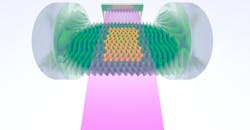Using a novel optical lattice, a team led by Stanford University is bringing sound to once-silent quantum experiments.
“Without sound or vibration, we miss a crucial degree of freedom that exists in real materials,” says Stanford researcher Benjamin Lev, an associate professor of physics and applied physics, in a release about the study. “It’s like making soup and forgetting the salt; it really takes the flavor out of the quantum ‘soup.’”
The new device, developed by Stanford, in conjunction with researchers from Pennsylvania State University and the University of St. Andrews (Scotland), is an optical lattice of atoms that incorporates sound quanta (phonons)—a first of its kind. The optical lattice “uses a crisscrossing mesh of laser beams to arrange atoms in an orderly manner resembling a crystal,” an approach commonly used to study the fundamental characteristics of solids as well as phases of matter with repeating geometries.
According to the study, published in Nature, “quantized sound waves—phonons—govern the elastic response of crystalline materials. “The physics of lattice phonons and elasticity is absent in simulators of quantum solids constructed of neutral atoms in periodic light potentials: unlike real solids, traditional optical lattices are silent because they are infinitely stiff.” Optical-lattice realizations of crystals therefore lack some of the central dynamical degrees of freedom that determine the low-temperature properties of real materials.” The new device affords elasticity.
"The cavity we use provides a lot more flexibility in terms of the shape of the light that bounces back and forth between the mirrors," Lev says. "It's as if, instead of just being allowed to make a single wave in a trough of water, you can now splash about to make any sort of wave pattern."
Specifically, the study involved designing a very precise cavity in which the lattice was held between two highly reflective mirrors. This allowed the atoms to essentially “’see’ themselves repeated thousands of times” via photons. According to the study, “this feedback causes the photons to behave like phonons—the building blocks of sound.”
The new optical lattice findings could allow for more in-depth study of the physics of elasticity in quantum solids, as well as the creation of quantum neural networks. Referring to phonons, Lev notes that “up until now, we couldn't study anything built upon that with quantum simulators employing atoms and photons because we couldn't emulate this basic form of sound."
About the Author
Justine Murphy
Multimedia Director, Digital Infrastructure
Justine Murphy is the multimedia director for Endeavor Business Media's Digital Infrastructure Group. She is a multiple award-winning writer and editor with more 20 years of experience in newspaper publishing as well as public relations, marketing, and communications. For nearly 10 years, she has covered all facets of the optics and photonics industry as an editor, writer, web news anchor, and podcast host for an internationally reaching magazine publishing company. Her work has earned accolades from the New England Press Association as well as the SIIA/Jesse H. Neal Awards. She received a B.A. from the Massachusetts College of Liberal Arts.

